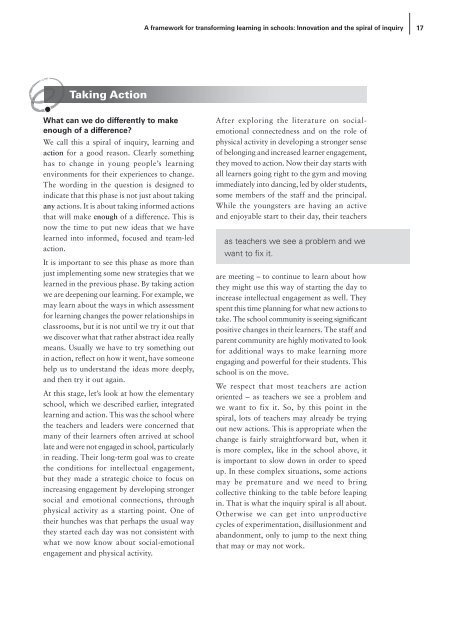Spiral of Inquiry
Spiral of Inquiry
Spiral of Inquiry
- No tags were found...
You also want an ePaper? Increase the reach of your titles
YUMPU automatically turns print PDFs into web optimized ePapers that Google loves.
A framework for transforming learning in schools: Innovation and the spiral <strong>of</strong> inquiry 17Taking ActionWhat can we do differently to makeenough <strong>of</strong> a difference?We call this a spiral <strong>of</strong> inquiry, learning andaction for a good reason. Clearly somethinghas to change in young people’s learningenvironments for their experiences to change.The wording in the question is designed toindicate that this phase is not just about takingany actions. It is about taking informed actionsthat will make enough <strong>of</strong> a difference. This isnow the time to put new ideas that we havelearned into informed, focused and team-ledaction.It is important to see this phase as more thanjust implementing some new strategies that welearned in the previous phase. By taking actionwe are deepening our learning. For example, wemay learn about the ways in which assessmentfor learning changes the power relationships inclassrooms, but it is not until we try it out thatwe discover what that rather abstract idea reallymeans. Usually we have to try something outin action, reflect on how it went, have someonehelp us to understand the ideas more deeply,and then try it out again.At this stage, let’s look at how the elementaryschool, which we described earlier, integratedlearning and action. This was the school wherethe teachers and leaders were concerned thatmany <strong>of</strong> their learners <strong>of</strong>ten arrived at schoollate and were not engaged in school, particularlyin reading. Their long-term goal was to createthe conditions for intellectual engagement,but they made a strategic choice to focus onincreasing engagement by developing strongersocial and emotional connections, throughphysical activity as a starting point. One <strong>of</strong>their hunches was that perhaps the usual waythey started each day was not consistent withwhat we now know about social-emotionalengagement and physical activity.After exploring the literature on socialemotionalconnectedness and on the role <strong>of</strong>physical activity in developing a stronger sense<strong>of</strong> belonging and increased learner engagement,they moved to action. Now their day starts withall learners going right to the gym and movingimmediately into dancing, led by older students,some members <strong>of</strong> the staff and the principal.While the youngsters are having an activeand enjoyable start to their day, their teachersas teachers we see a problem and wewant to fix it.are meeting – to continue to learn about howthey might use this way <strong>of</strong> starting the day toincrease intellectual engagement as well. Theyspent this time planning for what new actions totake. The school community is seeing significantpositive changes in their learners. The staff andparent community are highly motivated to lookfor additional ways to make learning moreengaging and powerful for their students. Thisschool is on the move.We respect that most teachers are actionoriented – as teachers we see a problem andwe want to fix it. So, by this point in thespiral, lots <strong>of</strong> teachers may already be tryingout new actions. This is appropriate when thechange is fairly straightforward but, when itis more complex, like in the school above, itis important to slow down in order to speedup. In these complex situations, some actionsmay be premature and we need to bringcollective thinking to the table before leapingin. That is what the inquiry spiral is all about.Otherwise we can get into unproductivecycles <strong>of</strong> experimentation, disillusionment andabandonment, only to jump to the next thingthat may or may not work.


